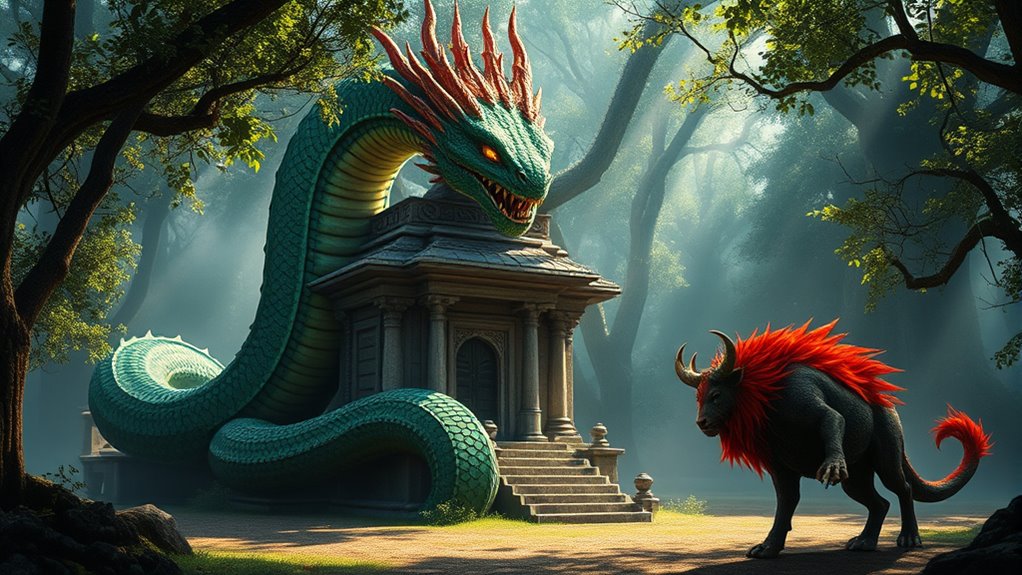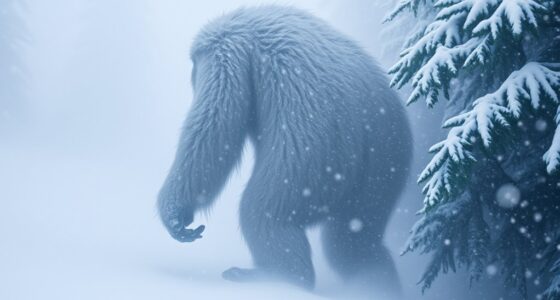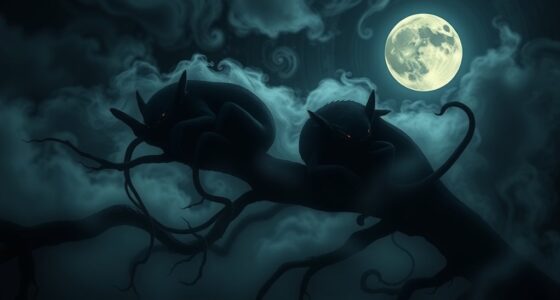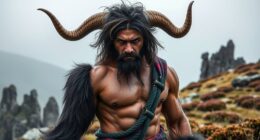In mythology, monsters can be both villains and guardians, depending on their story context and cultural meaning. Some serve as obstacles that heroes must overcome, symbolizing chaos or evil. Others act as protectors of sacred sites, treasures, or important values, embodying wisdom and strength. These dual roles show that monsters aren’t just frightening; they also represent important lessons about balance, protection, and the deeper aspects of human nature. Exploring further reveals even richer insights.
Key Takeaways
- Monsters symbolize dual roles, serving as both protectors and obstacles within cultural narratives.
- Some monsters act as guardians of sacred sites, treasures, or spiritual knowledge, embodying protective qualities.
- Villainous monsters often represent chaos, evil, or natural fears that heroes must confront or overcome.
- Cultural interpretations of monsters reflect societal values, highlighting their function as either benevolent protectors or destructive forces.
- Monsters challenge humans to confront fears and understand complex moral or spiritual lessons through mythic stories.
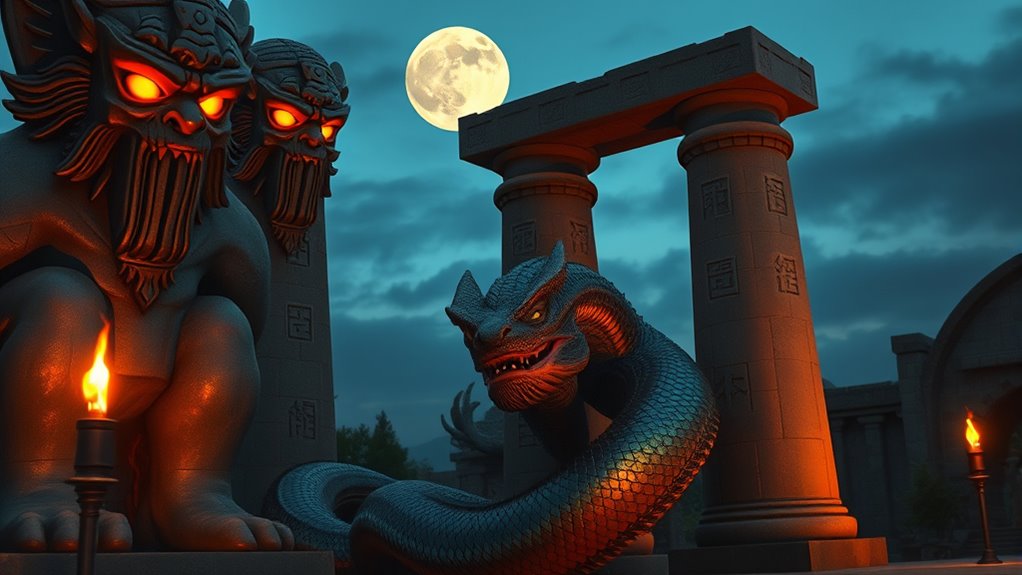
Have you ever wondered why monsters appear so frequently in mythologies around the world? These creatures often serve more than just frightening stories; they embody deeper meanings through mythic symbolism. Mythical creature symbolism varies widely across cultures, reflecting each society’s values, fears, and aspirations. In some traditions, monsters symbolize chaos, destruction, or evil, acting as obstacles that heroes must overcome to restore order. In others, they represent natural forces or spiritual lessons, embodying qualities that challenge humans to grow or understand themselves better. Across different cultural monster variations, you’ll find a fascinating spectrum—from the grotesque and terrifying to the wise and protective—highlighting how societies interpret the role of these beings within their worldview.
As you explore these cultural monster variations, you’ll notice that monsters aren’t always villainous. Sometimes, they serve as guardians or protectors, standing between humans and greater dangers. For example, in Chinese mythology, dragon-like creatures often symbolize power, wisdom, and protection. These monsters guard treasures, sacred sites, or even entire cities, embodying strength and resilience. In Norse legends, Jörmungandr, the world serpent, plays a dual role—an adversary in Ragnarok but also a symbol of the cosmic balance of forces. These creatures challenge heroes or gods, but their presence isn’t purely destructive; they often represent necessary parts of the universe’s order. Additionally, understanding the role of monsters in various mythologies can shed light on the importance of cultural symbolism in shaping collective beliefs and stories.
Your understanding of monsters as guardians versus villains hinges on their mythic symbolism. While some monsters are cast as villains to be defeated, others symbolize essential aspects of the natural or spiritual world that must be respected. Consider the Minotaur in Greek mythology: a creature born of chaos, yet also a symbol of human hubris and the primal forces lurking beneath civilization. Conversely, the turtle in many Native American stories acts as a guardian of the Earth, embodying stability and protection. These examples show that monsters can be complex figures, reflecting both fears and reverence within their respective cultures.
Ultimately, the role of monsters in mythology reveals a lot about human psychology and societal values. Whether they’re portrayed as villains to be vanquished or guardians to be revered, these creatures challenge us to confront our fears, understand the unknown, and find meaning within chaos. Mythical creature symbolism and cultural monster variations illustrate that monsters aren’t just monsters—they’re mirrors of our deepest truths and aspirations, shaped by the stories we tell to navigate the complexities of existence.
Frequently Asked Questions
How Do Different Cultures Classify Monsters as Guardians or Villains?
You see, different cultures classify monsters based on their cultural symbolism and mythological hierarchy. Guardians are often revered, believed to protect sacred sites or treasures, embodying strength and wisdom. Villains, however, are seen as destructive or chaos-causing beings. These classifications reflect a society’s values and beliefs, shaping how monsters are perceived—either as protectors or threats—within their mythological narratives.
What Psychological Functions Do Monsters Serve in Myths?
You might find it fascinating that 65% of mythological monsters symbolize archetypal fears, helping you confront subconscious symbolism. Monsters serve as psychological functions by embodying internal anxieties and unresolved conflicts, acting as mirrors of your psyche. They guide you through fears you may not fully understand, enabling growth and self-awareness. In myths, these creatures provide a safe space to explore complex emotions, making them essential for personal and collective psychological resilience.
Are There Modern Equivalents of Mythological Monsters in Popular Culture?
Yes, modern popular culture features equivalents of mythological monsters, embodying monster symbolism and mythological archetypes. You see this in movies, comics, and video games with creatures like dragons, zombies, or aliens, representing fears, challenges, or the unknown. These beings serve as modern guardians or villains, reflecting deep-seated psychological themes and societal anxieties, just like their mythological counterparts, allowing you to explore complex human emotions and archetypes visually and narratively.
How Do Monsters Reflect Societal Fears and Values?
Monsters serve as symbolic representations of societal anxieties and fears, revealing what a culture values or fears most. You see this in how they embody dangers like chaos, the unknown, or moral failings. By confronting monsters, societies process their fears and reinforce values like bravery or morality. These creatures reflect societal fears and values, helping communities understand and cope with issues that threaten stability or moral order.
Can Monsters in Mythology Represent Natural Phenomena or Environmental Issues?
You might find that monsters in mythology often symbolize natural phenomena or environmental issues through mythical symbolism and environmental allegories. These creatures could represent floods, storms, or other natural disasters, warning societies to respect nature’s power. By investigating these allegories, you see how ancient myths serve as cautionary tales, helping communities understand and cope with environmental challenges, making monsters a reflection of humanity’s relationship with the natural world.
Conclusion
So, next time you see a monster in mythology, remember—they’re not just evil villains. Sometimes, they’re the misunderstood guardians, or maybe just the universe’s way of saying, “Hey, let’s keep things interesting.” After all, what’s a boring world without a few monsters to spice things up? So, whether they protect or menace, one thing’s certain: monsters make mythology way more fun—and way more complicated—than we’d like to admit.

